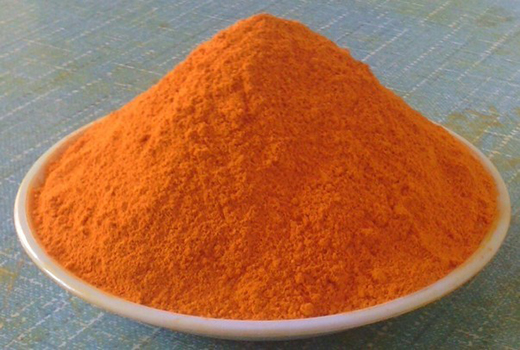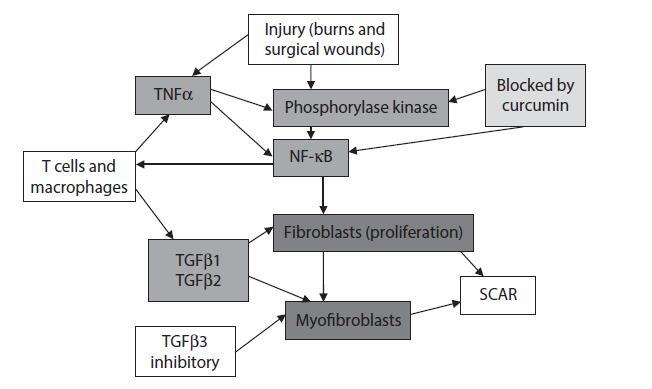Curcumin in Cosmetics: Biochemical Basis for Skin Repair with Use of Topical Curcumin
Curcumin is the active ingredient in turmeric, derived from the rhizome of Curcuma longa. Turmeric has been used in cosmetics and medicine in the Indian subcontinent for centuries. Turmeric itself contains turmerin,
essential oils and curcuminoids, including curcumin, the most biologically active of the ingredients.
Curcumin comprises 2%–8% of turmeric1 and is mainly responsible for the yellow color. The observed
anti-inflammatory properties of curcumin has led to its use as a therapeutic cosmetic. The colored curcuminoids,
however, have been found to be more potent than the colorless compounds, with curcumin
being the most potent of the colored curcuminoids.
The effectiveness of curcumin administered orally is hindered by its poor bioavailability due to the fact that the unconjugated curcumin molecule, which is hydrophobic, is poorly absorbed when taken orally, with very low curcumin levels detected in blood and tissues after ingestion. The molecule is usually absorbed by the gut as water-soluble curcumin metabolites (glucuronate or sulfate), with different anti-inflammatory properties from the unconjugated molecule. Topical curcumin is much better absorbed through the skin, particularly when the skin barrier is defective as in the presence of skin injury or disease.
An important and unique biochemical property of curcumin that makes it particularly useful for skin problems is that it is a selective and non-competitive inhibitor of phosphorylase kinase (PhK). PhK is released within minutes following skin injury, and is responsible for activating multiple signaling pathways involved in tissue inflammation. These may lead to scarring, dysregulated cell cycling, increased mitotic potential, and tumor promotion. The clinical manifestations of these cellular and tissue changes include thinning of the skin, pigmentary and keratotic lesions, and tumor transformation, particularly after solar injury. By inhibiting PhK, one of the earliest molecules involved in the injury pathway, curcumin blocks PhK-dependent signaling pathways, leading to mitigation of tissue injury. In this chapter, these injury processes and related signaling pathways that are targeted by curcumin will be detailed. The ability of curcumin to block these pathways may be the basis of the reparative properties of curcumin as a cosmetic, particularly in relation to anti-aging and possibly in the prevention of photocarcinogenesis in solar damaged skin. It may also be the basis of healing of burns and surgical wounds with minimal scarring. The use of topical curcumin in injured skin may, therefore, have widespread cosmetic and therapeutic implications.
Sequence of Early Events in Injury: Pathways Blocked by Curcumin
The sequence of early events after a skin injury at the molecular and biochemical level has been determined from investigations on the skin and other tissues. Much has been learnt from injured tissue after trauma, such as tape-stripping in the skin, burns, and other injuries. In a rat model of traumatic injury, NF-κB activation was observed as early as 30 minutes following induction of injury. The expression of inflammatory cytokines, including tumor necrosis factor-alpha (TNFα), interleukin -1beta (IL-1β), and the adhesion molecule intercellular adhesion molecule-1 (ICAM-1), was abrogated with inhibition of NF-κB by pyrrolidine dithiocarbamate (PDTC). This indicates that in injured tissues, cytokine and adhesion molecules are secreted downstream of NF-κB signaling.11 In our laboratory, we have observed increased activity of PhK in skin biopsies within 5 minutes after tape-stripping (Heng, unpublished data), In the tape-stripped epidermis, activated dendritic cells were also observed within 5 minutes following injury.8 In addition, in a rat model of an artery injury, we detected heat-shock protein 65 (hsp65) expression within minutes after arterial ligation and reperfusion injury. Heat shock protein-65 is a cognate antigen recognized by a dendritic subset of T lymphocytes expressing the γδ-T cell receptor. This dendritic subset is capable of secreting large amounts of inflammatory cytokines, including TNFα, and is among the earliest cells to infiltrate injured tissue.
Heat shock proteins (hsp 60/65/70) are expressed by injured cells and serve as an endogenous ligand for Toll-like receptors (TLR2 and TLR4) expressed on dendritic cells, resulting in secretion of cytokines such as TNFα by these and other inflammatory cells.14,15 In trauma-induced signaling, NF-κB expression was detected in macrophages and endothelial cells within 30 minutes following injury.10 NF-κB signaling is activated by PhK and inhibited by curcumin. The sequence of early events in injured skin is summarized in Figure 3.1. By blocking NF-κB signaling through inhibition of PhK, curcumin has the potential of preventing the secretion of cytokines, adhesion molecules, and growth factors, all of which occur downstream of NF-κB signaling. By using topical curcumin to block PhK/NF-κB/TNFα pathways, it may be possible to prevent inflammation-mediated tissue damage, and reduce the harmful effects of injury. The molecular and biochemical basis of the beneficial effects of curcumin on injured skin provides a hypothetical conceptual framework for the potential use of topical curcumin as a cosmetic and therapeutic agent for many types of skin problems.

Role of NF-κB in Injured Skin: Inhibition by Curcumin
Curcumin has also been found to be an indirect but potent inhibitor of NF-κB activation. Subsequent to injury, gene transcription is induced by the activation of transcription regulators. Perhaps the earliest major transcription regulator activated by injury is NF-κB. This transcription activator belongs to a family of related protein dimers that bind to a common sequence on DNA known as the kB site. In the nonactivated state, NF-κB exists as a pair of dimers (p50 and p65) located within the cytoplasm. After activation by injury, these dimers translocate to the nucleus, where they bind to DNA, and are responsible for activation of multiple genes following cell injury, including those for cell proliferation, cell migration, neovascularization, fibroblastic proliferation, inhibition of apoptosis, dysregulated cell cycling, and tumor transformation. In photodamaged skin, there may be dysregulated proliferation associated with decreased expression of the p53 suppressor gene, which is important for stabilizing DNA during replication. By upregulating p53 expression,20 curcumin has anti-photocarcinogenic properties.In inhibiting cell cycle progression,20 curcumin may also prevent skin malignancies in photodamaged skin.
Activation of NF-κB and IkBα Kinase: Blocked by Curcumin
The activation of NF-κB is triggered by tissue injury. In the skin, this includes trauma, heat, and laser burns, and ionizing and solar radiation. Following injury, activation of NF-κB involves phosphorylation at three serine specific sites (Ser-276, Ser-529, and Ser-536). In addition, before the NF-κB can translocate to the nucleus, the inhibitory molecule, IkBα, needs to be removed by activation of the enzyme, IkBα kinase. IkBα kinase (Figure 3.2) consists of three subunits—α and β subunits, and γ subunit (NEMO) that contains a zinc finger, with an ubiquitin-ligase binding site.22 Activation of IkB kinase requires phosphorylation of sites which are both serine specific and tyrosine specific: Ser-171, Ser-181 and Tyr-188, Tyr-199 on the β subunit, as well as phosphorylation of the zinc finger on the γ subunit. In UV light-induced injury, additional sites (Ser-32, Ser-36, Ser-68) are also phosphorylated.24 These multiple sites of phosphorylation required for activation of IkBα kinase (Figure 3.2) are dependent on PhK activity, and are inhibited by curcumin. The zinc finger of the γ subunit (NEMO) is selectively required for NF-κB activation by ultraviolet light radiation. The removal of the inhibitory IkBα molecule through activation of its kinase, IkBα kinase, enables the activated NF-κB dimers to translocate to the nucleus to activate the transcription of multiple genes, including a family of mitogen-activated protein kinases (MAP kinases), which are responsible for cell proliferation. Besides activating NF-κB, UV light injury may also induce activation of other transcription activators such as AP-1 (fos and jun), resulting in activation of c-jun N-terminal kinase (JNK), and the p38 MAPK pathway,26 Curcumin has also been shown to inhibit the c-jun/N-terminal kinase (JNK) signaling27 and c-fos/ERK (extracellular signal-regulated kinase) signaling in addition to blocking NF-κB activation.
NF-κB promotes carcinogenesis in skin and other tissues by increasing the cell survival kinase Akt (a serine-threonine kinase), and other NF-κB-dependent cell survival genes involving TRAF1 (TNFα receptor activating factor-1) and TRAF2 (TNFα receptor activating factor-2), which block apoptosis of photodamaged cells. Activation of NF-κB allows DNA-damaged and potentially malignant cells to survive. By blocking Akt31 and cell survival proteins, curcumin induces apoptosis of DNA damaged cells that are prone to undergo malignant transformation. This concept is consistent with the current notion that removal of potentially malignant cells by apoptosis is important in both the prevention and treatment of malignancy.
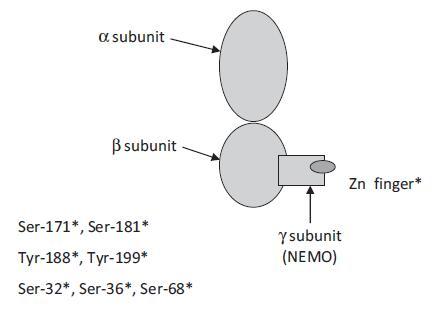
FIGURE 3.2 Details sites of phosphorylation involved in activation of IκBα kinase. This kinase contains three subunits, α, β, and γ (also called NEMO). The γ subunit (NEMO) contains a zinc finger and ubiquitin ligase site. Activation of IκBα kinase is blocked by curcumin. *Phosphorylation requirements for activation. (Reproduced with permission from Heng MC. Int J Dermatol 2013;62:531–43.)
Role of Phosphorylase Kinase in NF-κB and IkBα Kinase Activation: Inhibition by Curcumin
Phosphorylase kinase is a unique kinase in which the spatial arrangements of the specificity determinants can be manipulated to allow PhK to transfer high energy phosphate bonds from ATP to substrates of different specificities, such as serine/threonine and tyrosine. This is achieved by the presence of a hinge joint between the subunits of PhK, which allows changes in the size of the substrate binding site, as well as the ability to change the shape of the substrate binding site by binding either to Mg++ or Mn++ ions.36 Phosphorylation of multiple serine specific sites (Ser276, Ser529, and Ser536) on the NF-κB molecule is necessary for the initial partial activation of NF-κB.21 Additionally, phosphorylation of multiple serine specific (Ser171, Ser 181) and tyrosine specific (Tyr188, Tyr198) on the IkBα kinase (Figure 3.2) molecule is necessary for the removal of the inhibitory molecule (IkBα) in order that the activated NF-κB may translocate to the nucleus to bind to DNA for gene transcription. Additionally, the multiple phosphorylations of differing moieties5,6 such as serine/threonine in Akt, tyrosine in tyrosine kinases, and Thr and Tyr in JNK and p38 MAP kinase, require a dual specificity enzyme such as PhK. Using one enzyme, as with PhK, instead of several enzymes to achieve multiple biochemical functions, has the advantage of synchronization of phosphorylation events that require involvement of multiple sites and different specificities.
Mechanism of Action
Curcumin is a potent specific and non-competitive inhibitor of PhK. Its potential clinical use in a wide range of skin diseases and injuries is probably achieved through its inhibitory effect on PhK. By this action, curcumin may affect multiple pathways, including inhibition of IkBα/NF-κB16, and MAP/tyrosine kinase39,40-dependent proliferative pathways, induction of apoptosis by inhibiting the AKT-induced anti-apoptotic pathways,40 as well as inhibition of cyclin D1-mediated cell-cycling41 with salutary effects on proliferative activity and survival of tumor cells. It is believed that curcumin achieves these effects through its ability to inhibit PhK and block the phosphorylation events in these pathways. In addition, since PhK is responsible for generation of tissue ATP, which synergizes with TNFα to produce maturation of dendritic T cells42 necessary for the subsequent amplification of the inflammatory response, curcumin minimizes the magnitude of the inflammatory response. This may contribute significantly to its efficacy as a therapeutic cosmetic for the prevention of skin injury and the repair of damaged skin.
By blocking the pathways related to PhK activity, and NF-κB activation in dendritic cells, curcumin blocks multiple downstream inflammatory pathways which synergize to magnify the deleterious effects following injury. In the absence of curcumin, the injury cascade results in the subsequent secretion of cytokines and growth factors by both immune (T cells, macrophages, and mast cells) and non-immune cells (keratinocytes, fibroblasts, and endothelial cells) that serve to further amplify the immune response and cytokine load. In addition, the synergistic effect of the cytokines, growth factors, and chemokines acting through their respective receptors, trigger activation of multiple pathways and transcription factors that result in gene transcription of multiple genes, with magnification of the deleterious effects on the skin following injury.
The ability of curcumin to block the early stages of the inflammatory cascade triggered by injury may also be the basis for its potential or reported ability to heal burns with minimal scarring, to heal surgical wounds with “perfect regeneration,” and to repair photodamaged and photoaging skin. By blocking PhK activity, curcumin also blocks ATP generation. This has the effect of preventing the maturation of dendritic cells since ATP has been shown to synergize with TNFα to promote dendritic cell activation and maturation. By preventing dendritic cell maturation, curcumin may function to curb the amplification of the injury-induced inflammatory response, which is particularly important in the prevention of excessive scarring after burns, and in the healing of skin damaged by solar injury and ionizing radiation.
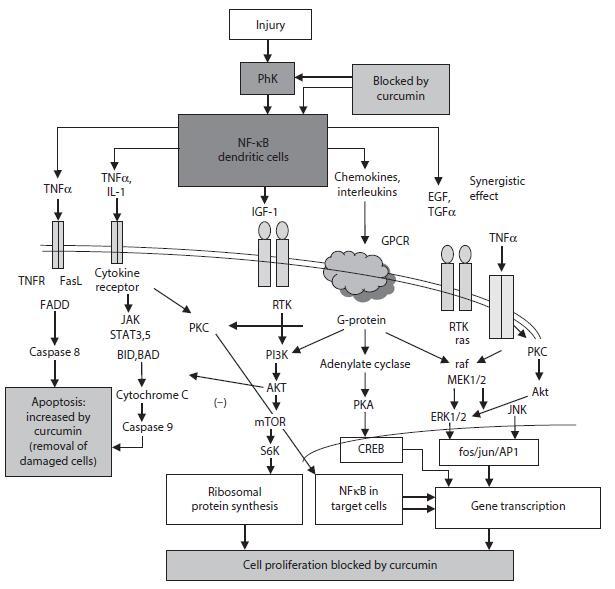
FIGURE 3.3 Summarizes the NF-κB-dependent signaling pathways blocked by curcumin through inhibition of phosphorylase
kinase activity. By blocking NK-κB activity in the dendritic cells, curcumin is capable of blocking TNFα-dependent
and cytokine-dependent pathways and receptor-mediated tyrosine–kinase gene-dependent gene transcription in target cells.
Phosphorylase kinase is necessary for ATP generation, which synergizes with TNFα to cause dendritic cell maturation.
REFERENCES
1. Sharma RA, Steward WP, Gescher AJ. Pharmacokinetics and pharmacodynamics of curcumin. Adv Exp Med Biol 2007;595:453–70.
2. Jurenka JS. Anti-inflammatory properties of curcumin, a major constituent of Curcuma longa: A review of preclinical and clinical research. Altern Med Rev 2009;14:141–53.
3. Arnand P, Kunnumakkara AB, Newman RA et al. Bioavailability of curcumin: Problems and promises. Mol Pharm 2007;4(6):807–18.
4. Reddy S, Aggarwal BB. Curcumin is a non-competitive and selective inhibitor of phosphorylase kinase. FEBS Lett 1994;341:19–22.
5. Heng MC. Curcumin-targeted signaling pathways: Basis for anti-photoaging and anti-carcinogenic therapy. Int J Dermatol 2010;49:608–22.
6. Heng MC. Signaling pathways target by curcumin in acute and chronic injury: Burns and photodamaged skin. Int J Dermatol 2013;62:531–43.
7. Heng MC. Wound healing in adult skin: Aiming for perfect regeneration. Int J Dermatol 2011;50:1058–66.
8. Heng MC, Kloss SG, Kuehn CS et al. The sequence of events in psoriatic plaque formation after tapestripping. Br J Dermatol 1985;112:517–32.
9. Feezor RJ, Paddock HN, Baker HV et al. Temporal patterns of gene expression of gene expression in murine cutaneous burn wound healing. Physiol Genomics 2004;16:341–8.
10. Bethea JR, Castro M, Keane RW et al. Traumatic spinal cord injury induces nuclear factor-κB activation. J Neurosci 1998;18:3251–60.
);You may like
Related articles And Qustion
Lastest Price from Curcumin manufacturers
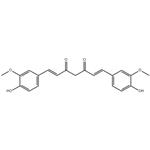
US $10.00-3.00/KG2024-04-27
- CAS:
- 458-37-7
- Min. Order:
- 1KG
- Purity:
- 99%
- Supply Ability:
- g-kg-tons, free sample is available
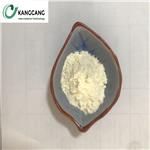
US $9.00-70.00/g2024-04-26
- CAS:
- 458-37-7
- Min. Order:
- 10g
- Purity:
- 99%
- Supply Ability:
- 10 tons

